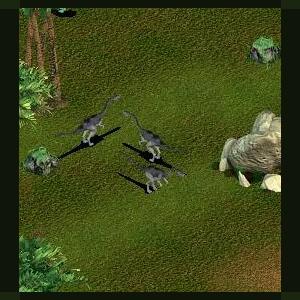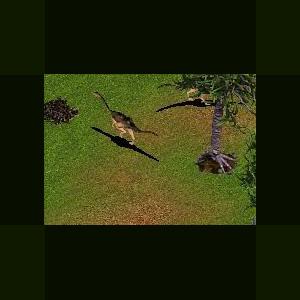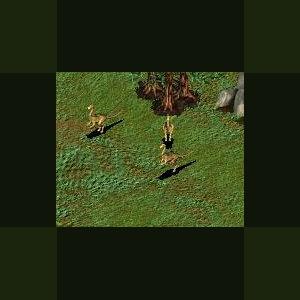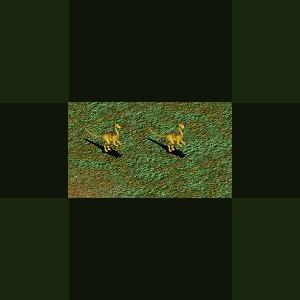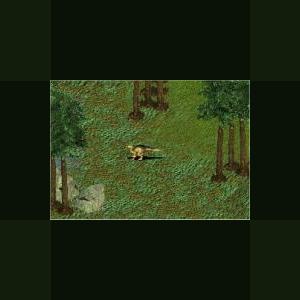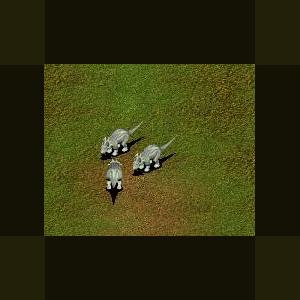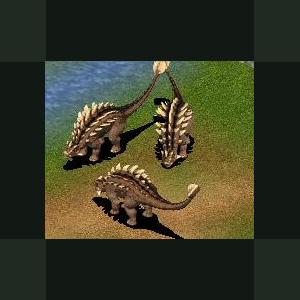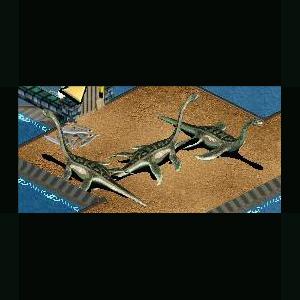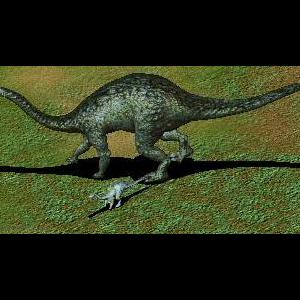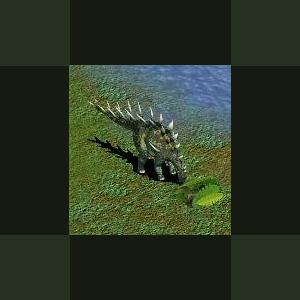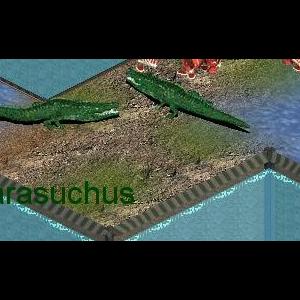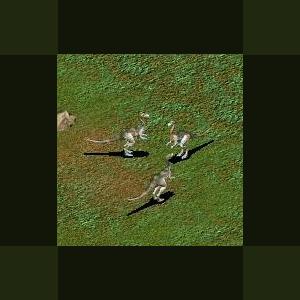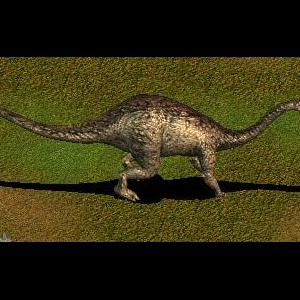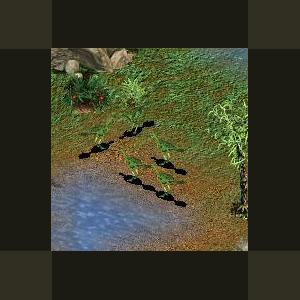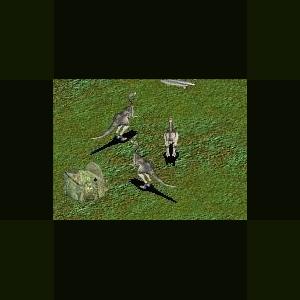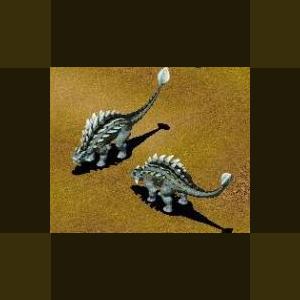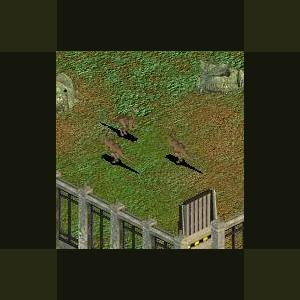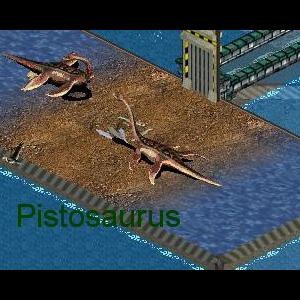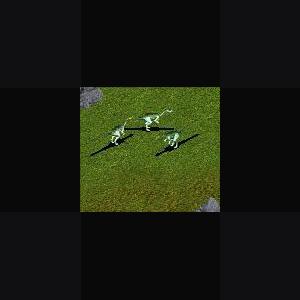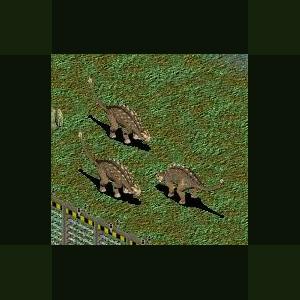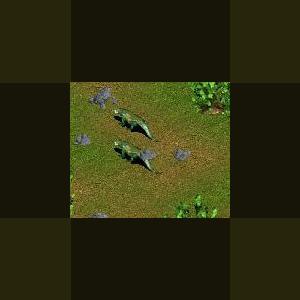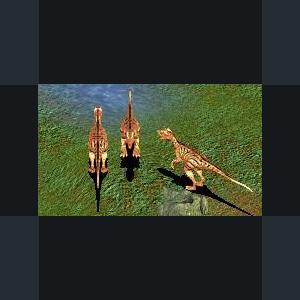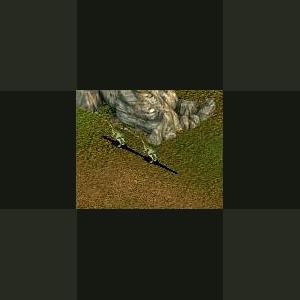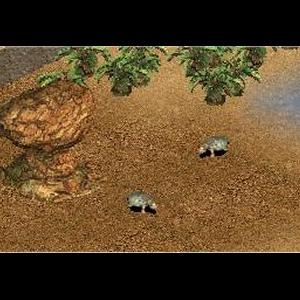Dinosaurs
Creatures from another age
241 files
-
Ornitholestes by Moondawg
By Guest
Ornitholestes
Ornitholestes ("bird robber") was a small theropod dinosaur of the late Jurassic of Western Laurasia (the area that was to become North America). Almost everything known of this species comes from a single skeleton of Ornitholestes, found near Como Bluff in 1900, and described by Henry Fairfield Osborn in 1903. A hand was later attributed to Ornitholestes, although this attribution is now in doubt. The species name honours the AMNH preparator Adam Hermann.
Ornitholestes was roughly 2 meters (6.5 ft) in length. The head of Ornitholestes was relatively small. Nonetheless, the skull was more robust than that of many other small theropods, such as Compsognathus and Coelophysis, and this would have enabled Ornitholestes to deliver a powerful bite.
Gregory S. Paul suggested the presence of a small horn on the snout of Ornitholestes, similar to that of Proceratosaurus. however this has recently been disproved by Carpenter et al., which indicated that the 'crest' was actually a broken nasal bone. Like most other theropods, Ornitholestes had a long tail, presumably used for balance
Ornitholestes was a coelurosaur, similar in many ways to Compsognathus, though somewhat larger.
The sharp teeth of Ornitholestes clearly identify it as a carnivore, but its exact diet has been a subject of debate in the paleontological community.
In his original 1903 description, Henry Fairfield Osborn suggested that Ornitholestes might have preyed on contemporary birds, based on the "rapid grasping power of agile and delicate prey" suggested by the structure of the hand. In 1917, however, Osborn reevaluated the hand and determined that it was unsuitable for this purpose.
More recently, Robert T. Bakker speculated that Ornitholestes probably hunted small mammals, noting that "the Como furballs were just the right size to fit the predator's jaws."
207 downloads
0 comments
Updated
-
Ornithomimus by Moondawg
By Guest
Ornithomimus velox was named on the basis of a foot and partial hand from the Maastrichtian Denver Formation, but better material has since been found in Canada, including the Edmontonian-age Ornithomimus edmontonicus and an excellent articulated specimen (species unknown) from Dinosaur Provincial Park. Other specimens of Ornithomimus have been discovered on the Eastern Coast of the USA
Like other ornithomimids, Ornithomimus is characterized by a three-toed foot, long slender arms and a long neck with a birdlike skull. It differs from other ornithomimids, such as Struthiomimus, in having very slender, straight hand and foot claws and in having metacarpals and fingers of similar lengths.Its hands are remarkably sloth-like in appearance, which led Henry Fairfield Osborn to suggest that they were used to hook branches during feeding.
Ornithomimus was 12 ft (3.5 meters) long, 7 feet (2.10 meters) high and weighed around 100-150 kg. It was bipedal and superficially resembled an ostrich, except for its long tail. It would have been a swift runner.
274 downloads
0 comments
Updated
-
Orodromeus by Moondawg
By Guest
Orodromeus
Orodromeus was a genus of hypsilophodont dinosaur from Late Cretaceous North America (Campanian age). It was a small herbivore that probably coexisted with dinosaurs such as Daspletosaurus and Einiosaurus. It lived in what is now Montana some 75 million years ago, being apparently only known from the Two Medicine Formation. The type species, Orodromeus makelai, was described by Horner and Weishampel in 1988.
It has been speculated that this animal may have burrowed much like its relative Oryctodromeus, based upon the packing of their bones in situations where they typically would have been scattered.
131 downloads
0 comments
Updated
-
Oryctodromeus by Moondawg
By Guest
Oryctodromeus
Oryctodromeus (meaning "digging runner") was a genus of small ornithopod dinosaur, the fossilized remains of which have been found in rocks dating from the middle Cretaceous Blackleaf Formation of southwestern Montana (Cenomanian stage), roughly 95 million years ago. A member of the small, presumably fast-running herbivorous family Hypsilophodontidae, Oryctodromeus is the first dinosaur published that shows evidence of burrowing behavior.
Oryctodromeus is based on MOR 1636a, a partial skeleton of an adult individual including: the premaxillae (upper beak); part of the braincase; three neck, six back, seven hip, and twenty-three tail vertebrae; ribs; the shoulder girdle; an arm (minus the hand); both tibiae and an incomplete fibula; and a metatarsal. Two additional individuals, both juveniles about 55 to 65% the size of MOR 1636a, are represented by MOR 1636b. Unlike many other ornithopod dinosaurs, Oryctodromeus lacked bony tendons that stiffened the tail, which would have made moving about inside a small burrow easier. Additionally, it shows adaptations in the jaws, forelimbs, and pelvis that could have helped move and manipulate soil.
The authors pointed out that Oryctodromeus had only modest forelimb modifications in comparison to dedicated burrowing animals, like moles, echidnas, and wombats. Instead, it was comparable to, but somewhat more specialized for digging than animals that both run and burrow today, like aardwolves, cavies, hyenas, and rabbits. Because it was a biped, it could have a more modified forelimb without affecting its ability to run.
Under a cladistic analysis, Oryctodromeus was found to be basal within Euornithopoda and a close relative of the hypsilophodonts Orodromeus and Zephyrosaurus, which are also known from the Cretaceous of Montana. These two animals share adaptations with Oryctodromeus that may have been used for burrowing, such as a broad snout. Additionally, Orodromeus specimens have been found preserved in a similar way, suggesting that they too were in burrows. This would not be the first time that a hypsilophodont has been suggested as a burrower; Robert Bakker has informally claimed since the 1990s that Drinker, from the late Jurassic of Wyoming, lived in burrows, but this has yet to be published.
The three Oryctodromeus individuals were found buried within the remains of an underground den or burrow, measuring about 2 meters long (6.5 feet) and 70 centimeters wide (2.3 ft). The skeletons were densely packed and disarticulated, indicating that the animals died and decayed within the burrow. The burrow is similar to those made by hyenas and puffins today. It was filled with sand, and the resulting sandstone stands out against the surrounding mudstone and claystone.
There are two turns in the preserved burrow section, and smaller secondary sandstone cylinders of various sizes (a few centimeters or inches in cross-section at most) that were probably made by smaller animals sharing the burrow (commensal). The burrow closely fits the probable proportions of the adult dinosaur, another indication that it was the digger.
As a hypsilophodont, Oryctodromeus would have been a small, swift herbivore. This aspect, coupled with where it was discovered, gives it its name: Oryctodromeus cubicularis translates as "digging runner of the lair", in reference to its presumed lifestyle. The adult Oryctodromeus itself measured 2.1 m long (6.8 ft) and would have weighed about 22-32 kilograms (50-70 pounds), and the juveniles would have been about 1.3 m long (4.3 ft). The presence of juveniles with the adult suggests parental care, and that at least one motivation for burrowing was to rear the juveniles. The size of the juveniles suggests an extended period of parental care.
130 downloads
0 comments
Updated
-
Othnielia by Ghirin
By Guest
Othnielia Author: Ghirin
Othnielia, a small ornithopod dinosaur, was named in honor of paleiotologist Othniel Charles Marsh.
*Inspired by the Zoo Tycoon Brains Trust at the Zoo Tek Evolved Forums.
175 downloads
0 comments
Updated
-
Pachyrhinosaurus by Moondawg
By Guest
Pachyrhinosaurus
Pachyrhinosaurus (meaning "thick-nosed reptile") is a genus of ceratopsid dinosaur from the Late Cretaceous period of North America. The first examples were discovered by Charles M. Sternberg in Alberta, Canada, in 1946, and named in 1950. Twelve partial skulls and a large assortment of fossils have been found in total in Alberta and Alaska. A great number were not available for study until the 1980s, resulting in a relatively recent increase of interest in the Pachyrhinosaurus. Instead of horns, the skull bears massive, flattened bosses, the largest being over the nose. These were probably used in butting and shoving matches, as in musk oxen. A single pair of horns grew from the frill and extended upwards. It appears that that both the shape and size of the frill was highly individualized, reliant on gender and perhaps other factors. Pachyrhinosaurus is most closely related to Achelousaurus.
Pachyrhinosaurus was 5.5 to 7 meters (18 to 23 ft) long. It weighed about four tons. It was herbivorous and possessed strong cheek teeth to help it chew tough, fibrous plants.
The type species, Pachyrhinosaurus canadensis, was described in 1950 by Charles Mortram Sternberg.
In 1972, Grande Prairie, Alberta science teacher Al Lakusta found a large bonebed along Pipestone Creek in Alberta. When the area was finally excavated between 1986 and 1989 by staff and volunteers of the Royal Tyrrell Museum of Palaeontology, paleontologists discovered an amazingly large and dense selection of bones--up to 100 per square meter, with a total of 3500 bones and 14 skulls. This was apparently the site of a mass mortality, perhaps a failed attempt to cross the river during a flood. Found amongst the fossils were the skeletons of four distinct age groups ranging from juveniles to full grown dinosaurs, indicating that the Pachyrhinosaurus did indeed care for their young.
The adult skulls had both convex and concave bosses as well as unicorn-style horns on the parietal bone just behind their eyes. The concave boss types might be related to erosion only and not reflect male/female differences. In 2008, a detailed monograph describing the skull of the Pipestone Creek pachyrhinosaur, and penned by Philip J. Currie, Wann Langston, Jr., and Darren Tanke, classified the specimen as a second species of Pachyrhinosaurus, named P. lakustai after its discoverer
300 downloads
0 comments
Updated
-
Panoplosaurus by Moondawg
By Guest
Pantosaurus is an extinct genus of plesiosaur from the Late Jurassic (Oxfordian) of what is now Wyoming. It lived in what used to be the Sundance Sea.
The species Muraenosaurus reedii is in fact a junior synonym of Pantosaurus
Pantosaurus possesses between 35 and 40 cervical vertebrae, which are very similar in proportion and morphology to those of Muraenosaurus leedsii from the Oxford Clay Formation (Callovian, Middle Jurassic) of England. The forelimb of Pantosaurus however can be differentiated from that of Muraenosaurus, such as the relatively large size of the radius and the corresponding humerus-radius articulation. No Pantosaurus cranial material has yet been discovered.
166 downloads
0 comments
Updated
-
Pantosaurus by Moondawg
By Guest
Pantosaurus is an extinct genus of plesiosaur from the Late Jurassic (Oxfordian) of what is now Wyoming. It lived in what used to be the Sundance Sea.
The species Muraenosaurus reedii is in fact a junior synonym of Pantosaurus
Pantosaurus possesses between 35 and 40 cervical vertebrae, which are very similar in proportion and morphology to those of Muraenosaurus leedsii from the Oxford Clay Formation (Callovian, Middle Jurassic) of England. The forelimb of Pantosaurus however can be differentiated from that of Muraenosaurus, such as the relatively large size of the radius and the corresponding humerus-radius articulation. No Pantosaurus cranial material has yet been discovered.
199 downloads
0 comments
Updated
-
Paralititan by Moondawg
By Guest
Paralititan stromeri was a giant titanosaurian sauropod dinosaur discovered in coastal deposits in the Upper Cretaceous Bahariya Formation of Egypt.
The fossil represents the first tetrapod reported from the Bahariya Formation since 1935. Its 1.69 meter (5.54 ft) long humerus is longer than that of any known Cretaceous sauropod. The autochthonous, scavenged skeleton was preserved in tidal flat deposits containing fossil mangrove vegetation. The mangrove ecosystem it inhabited was situated along the southern shore of the Tethys Sea. Paralititan is the first dinosaur demonstrated to have inhabited a mangrove biome.
Little of Paralititan is known, so its exact size is difficult to estimate. However the limited material suggests that it is one of the most massive dinosaurs ever discovered, with an estimated weight of 59 tonnes (65 short tons). Using Saltasaurus as a guide, Carpenter estimated its length at around 26 meters (85 ft). Like other titanosaurs, it had a wide-gauge stance and may have possessed osteoderms for defense. The Paralititan type specimen appears to have been scavenged by a meat-eater. It is also possible that Paralititan was hunted by large predatory dinosaurs such as Carcharodontosaurus.
Paralititan stromeri means "Stromer's tidal (Greek para + halos "near sea") titan". It was named by Joshua B. Smith, Matthew C. Lamanna, Kenneth J. Lacovara, Peter Dodson, Jennifer R. Smith, Jason C. Poole, Robert Giegengack and Yousri Attia in 2001 to honor Ernst Stromer von Reichenbach, a German paleontologist and geologist who found dinosaurs in this area in the early 1900s.
184 downloads
0 comments
Updated
-
Paranthodon by Moondawg
By Guest
Paranthodon (Meaning "Beside Anthodon") was a dinosaur from the middle of the Cretaceous. It lived in what is now South Africa.
It is classified as a stegosaur. The type species, Paranthodon africanus, comes from a partial skull first described as Palaeoscincus africanus in 1912. It was reclassified as Paranthodon africanus in 1929 by the famed Franz von Nopsca. It owes its name to the fact that its jaw was found near the fossils of a Permian pareiasaur named Anthodon.
* Inspired by the Zoo Tek Brains Trust
175 downloads
0 comments
Updated
-
Parasuchus by Moondawg
By Guest
Parasuchus was a genus of several crocodile-like semi-aquatic animals that lived in the Late Triassic, specifically the earlier Late Carnian period. The reptiles lived throughout Europe, North America, and North Africa.
203 downloads
0 comments
Updated
-
Parksosaurus by Moondawg
By Guest
Parksosaurus
Parksosaurus ("William Parks's lizard") was a genus of hypsilophodont ornithopod dinosaur from the early Maastrichtian-age Upper Cretaceous Horseshoe Canyon Formation of Alberta, Canada. It is based on most of a partially articulated skeleton and partial skull, showing it to have been a small, bipedal, herbivorous dinosaur. It is one of the few described non-hadrosaurid ornithopods from the end of the Cretaceous in North America, existing around 70 million years ago.
Explicit estimates of the entire size of the animal have not been done, but William Parks found the hindlimb of his T. warreni to be about the same length overall as that of Thescelosaurus neglectus (93.0 centimeters (3.05 ft) for T. warreni versus 95.5 centimeters (3.13 ft) for T. neglectus), even though the shin was shorter than the thigh in T. neglectus, the opposite of T. warreni. Thus, the animal would have been comparable to the better-known Thescelosaurus in linear dimensions, despite proportional differences (around 1 meter (3.3 ft) tall at the hips, 2-2.5 meters (6.56-8.2 ft) long). The proportional differences probably would have made it lighter, though, as less weight was concentrated near the thigh. Like Thescelosaurus, it had thin cartilaginous plates along the ribs.
Parksosaurus has been considered to be a hypsilophodont since its description. Recent reviews have dealt with it with little comment, although David B. Norman and colleagues (2004), in the framework of a paraphyletic Hypsilophodontidae, found it to be the sister taxon to Thescelosaurus, and Richard Butler and colleagues (2008) found that it may be close to the South American genus Gasparinisaura. However, basal ornithopod phylogeny is poorly known at this point, albeit under study. Like Thescelosaurus, Parksosaurus had a relatively robust hindlimb, and an elongate skull without as much of an arched shape to the forehead compared to other hypsilophodonts.
Paleontologist William Parks described skeleton ROM 804 in 1926 as Thescelosaurus warreni, which had been discovered in what was then called the Edmonton Formation near Rumsey Ferry on the Red Deer River. When found, it consisted of a partial skull missing the beak region, most of the left pectoral girdle (including a suprascapula, a bone more commonly found in lizards, but which is believed to have been present in cartilaginous form in some ornithopods due to the roughened ends of their scapulae), the left arm except the hand, ribs and sternal elements, a damaged left pelvis, right ischium, the left leg except for some toe bones, articulated vertebrae from the back, hip, and tail, and a number of ossified tendons that sheathed the end of the tail. The body of the animal had fallen on its left side, and most of the right side had been destroyed before burial; in addition, the head had been separated from the body, and the neck lost. Parks differentiated the new species from T. neglectus by leg proportions; T. warreni had a longer tibia than femur, and longer toes.
Charles M. Sternberg, upon the discovery of the specimen he named Thescelosaurus edmontonensis, revisited T. warreni and found that it warranted its own genus (it was named in an abstract, which is not typical, but the specimen had already been thoroughly described). In 1940, he presented a more thorough comparison and found a number of differences between the two genera throughout the body. He assigned Parksosaurus to the Hypsilophodontinae with Hypsilophodon and Dysalotosaurus, and Thescelosaurus to the Thescelosaurinae. The genus attracted little attention until Peter Galton began his revision of hypsilophodonts in the 1970s. Parksosaurus received a redescription in 1973, wherein it was considered to be related to a Hypsilophodon\Laosaurus\L. minimus lineage. After this, it once again returned to obscurity.
George Olshevsky emended the species name to P. warrenae in 1992, because the species name honors a woman (Mrs. H. D. Warren), but outside of Internet sites, the original spelling has been preferred.
Parksosaurus shared the Horseshoe Canyon Formation with flat-headed hadrosaurid Edmontosaurus, spike-crested Saurolophus, and hollow-crested Hypacrosaurus, ankylosaurid Euoplocephalus, nodosaurid Edmontonia, horned dinosaurs Montanoceratops, Anchiceratops, Arrhinoceratops, and Pachyrhinosaurus, pachycephalosaurid Stegoceras, ostrich-mimics Ornithomimus and Struthiomimus, a variety of poorly-known small theropods including troodontids and dromaeosaurids, and the tyrannosaurids Albertosaurus and Daspletosaurus. The dinosaurs from this formation are sometimes known as Edmontonian, after a land mammal age, and are distinct from those in the formations above and below. The Horseshoe Canyon Formation is interpreted as having a significant marine influence, due to an encroaching Western Interior Seaway, the shallow sea that covered the midsection of North America through much of the Cretaceous.
In life, Parksosaurus, as a hypsilophodont, would have been a small, swift bipedal herbivore. It would have had a moderately long neck and small head with a horny beak, short but strong forelimbs, and long powerful hindlimbs.
123 downloads
0 comments
Updated
-
Patagosaurus by Moondawg
By Guest
Patagosaurus
Patagosaurus (meaning "Patagonian lizard") was a large herbivorous dinosaur from the long-necked group Sauropoda. It reached the length of 18 meters. Similar to other primitive eusauropods, it was rather heavily build and similar to Cetiosaurus in general appearance. It is known from a dozen individuals, though some referred material may belong to another related dinosaur genus. It lived during the Callovian of the Middle Jurassic (163-161 mya) in what is now called Argentina. Other Argentinian dinosaurs living approximately at the same time were Piatnitzkysaurus, Condorraptor and Amygdalodon.
133 downloads
0 comments
Updated
-
Pedopenna by Moondawg
By Guest
Pedopenna
Pedopenna ("foot feather") was a small, feathered, maniraptoran dinosaur from the Daohugou Beds in China. It is possibly older than Archaeopteryx, though the age of the Daohugou Beds where it was found is debated. Some estimates give an Early Cretaceous age, but the latest radiometric dating shows them to be late Middle Jurassic (Callovian) (c.140-168 mya).
The name Pedopenna refers to the long pennaceous feathers on the metatarsus; daohugouensis refers to the locality of Daohugou, where the holotype was found. Pedopenna daohugouensis probably measured 1 meter (3 ft) or less in length, but since this species is only known from the hind legs, the actual length is difficult to estimate. Pedopenna is classified as a paravian (Paraves), the group of maniraptoran dinosaurs that includes Aves and their closest relatives.
The feet of Pedopenna resembled those of the related troodontids and dromaeosaurids (which together form the group Deinonychosauria), though were overall more primitive. In particular, the second toe of Pedopenna was not as specialized as in deinonychosaurs. While Pedopenna did have an enlarged claw and slightly shortened second toe, it was not as highly developed as the strongly curved, sickle-like claws of its relatives.
Xu and Zhang, who interpreted the Daohugou fossil beds where Pedopenna was found as mid to late Jurassic in age, used the presence of such a primitive member of the avian lineage, in combination with many primitive members of closely related lineages there, to support the idea that birds originated in Asia.
The avian affinities of Pedopenna are further evidence of the dinosaur-bird evolutionary relationship. Apart from having a very bird-like skeletal structure in its legs, Pedopenna was remarkable due to the presence of long pennaceous feathers on the metatarsus (foot). Some deinonychosaurs are also known to have these 'hind wings', but those of Pedopenna differ from those of animals like Microraptor. Pedopenna hind wings were smaller and more rounded in shape. The longest feathers were slightly shorter than the metatarsus, at about 55 mm (2 in) long. Additionally, the feathers of Pedopenna were symmetrical, unlike the asymmetrical feathers of some deinonychosaurs and birds. Since asymmetrical feathers are typical of animals adapted to flying, it is likely that Pedopenna represents an early stage in the development of these structures. While many of the feather impressions in the fossil are weak, it is clear that each possessed a rachis and barbs, and while the exact number of foot feathers is uncertain, they are more numerous than in the hind-wings of Microraptor. Pedopenna also shows evidence of shorter feathers overlying the long foot feathers, evidence for the presence of coverts as seen in modern birds. Since the feathers show fewer aerodynamic adaptations than the similar hind wings of Microraptor, and appear to be less stiff, suggests that if they did have some kind of aerodynamic function, it was much weaker than in deinonychosaurs and birds. Xu and Zhang, in their 2005 description of Pedopenna, suggested that the feathers could be ornamental, or even vestigial. It is possible that a hind wing was present in the ancestors of deinonychosaurs and birds, and later lost in the bird lineage, with Pedopenna representing an intermediate stage where the hind wings are being reduced from a functional gliding apparatus to a display or insulatory function.
139 downloads
0 comments
Updated
-
Pelecanimimus by Moondawg
By Guest
Pelecanimimus was a small ornithomimosaur, at about 2-2.5 m long (6.5 - 8 ft). Its skull was unusually long and narrow, with a maximum length of about 4.5 times its maximum height. It was highly unusual among ornithomimosaurs in its large number of teeth: it had about 220 very small teeth in total, with 7 premaxillary, about 30 maxillary, and 75 in the dentary. The teeth were heterodont, showing two different basic forms. The teeth in the front of the upper jaw were broad and D-shaped in cross section, while those further back were blade-like, and on the whole the teeth in the upper jaw were larger than those in the lower. All of its teeth were unserrated, and had a constricted "waist" between the crown and the root.
Only one other ornithomimosaur is known to possess teeth, Harpymimus, which had far fewer (eleven total, and only in the lower jaw). The presence of such a large number of teeth in Pelecanimimus, coupled with a lack of interdental space, was interpreted by Perez-Moreno et al. as an adaptation for cutting and ripping, a "functional counterpart of the cutting edge of a beak," as well as an exaptation leading to the toothless cutting edge found in later ornithomimosaurs.
The arms and hands of Pelecanimimus were more typical of ornithomimosaurs, with the ulna and radius bones in the lower arm tightly adhered close to the hand, which were hook-like and had fingers of equal length.
Soft-tissue impressions preserved by the exceptional preservational environment of the La Hoyas lagerstätten revealed the presence of a small skin or keratin crest on the back of the head, and a gular pouch similar to the much larger pouches found in modern pelicans, from which Pelecanimimus took its name. Pelecanimimus might have been much like a modern day crane, wading out in lakes or ponds using its claws and teeth to capture fish and then storing them in its skin flap. Some parts of the impressions revealed a smooth, skin-like surface, initially interpreted as lacking any ornamentation or feathers. Pelecanimimus was also the first ornithomimosaur discovered with a preserved hyoid apparatus (specialized bones in the neck).
A cladistic analyses by Makovicky et al. (2005) indicated that Pelecanimimus is the basalmost member of the Ornithomimosauria, less derived even than Harpymimus. A study by Kobayashi and Lü in 2003 indicated that these two species formed a basal arrangement of steps leading towards the more advanced ornithomimids (see cladogram below). The discovery of Pelecanimimus has played an important and surprising role in understanding the evolution of the Ornithomimosauria. To quote Pérez-Moreno et al., "The phylogenetic hypothesis...supports an unexpected approach, involving exaptation, which might explain the evolutionary process towards the toothless condition in Ornithomimosauria. Until now, a progressive reduction in the number of teeth has been considered as the most likely explanation: the primitive tetanurine theropods have up to 80 teeth with tall blade-like crowns, and the primitive ornithomimosaurs have only a few small teeth. The phylogenetic hypothesis suggests an alternative evolutionary process based on a functional analysis of increasing numbers of teeth. A high number of teeth with enough interdental space and properly placed denticles (as in troodontids) would be an adaptation for cutting and ripping. On the other hand, an excessive number of teeth with no interdental space (as in Pelecanimimus) would be a functional counterpart of the cutting edge of a beak. Thus, increasing the number of teeth would be an adaptation for cutting and ripping, as long as the space between adjacent teeth was preserved...while it would have the effect of working as a beak if spaces were filled with more teeth. The adaption to a cut-and-rip function therefore becomes an exaptation with a slicing effect, eventually leading to the cutting edge seen in most ornithomimosaurs."
137 downloads
0 comments
Updated
-
Pinacosaurus by Moondawg
By Guest
Pinacosaurus ("plank lizard") is a genus of medium-sized ankylosaur dinosaurs that lived from the late Santonian to the late Campanian stages of the late Cretaceous period.
Pinacosaurus was a lightly-built, medium-sized ankylosaur with a long skull that reached a length of 5 meters (16 ft) Like all ankylosaurids, it had a bony club at the end of its tail which it used as a defensive weapon against predators such as Tarbosaurus. The most unusual element in the original specimen is the presence of two additional egg-shaped holes, one on top of the other, where the nostrils are normally found. The openings are characteristic of the genus, and the number varies: Godefroit et al. described four in 1999, and in 2003 a juvenile specimen with of five pairs of openings was described.
* Inspired by the Zoo Tek Brains Trust
162 downloads
0 comments
Updated
-
Pisanosaurus by Moondawg
By Guest
Pisanosaurus
Pisanosaurus mertii (the name comes from "Pisano", who was an associate of the finder, and "saurus" meaning lizard or reptile) is a primitive bipedal Ornithischian dinosaur from the Late Triassic.
Pisanosaurus was 3.2 feet (1 meter) in length and 12 inches (30.48 centimeters) in height. Its weight estimate is just under 8.8 pounds (four kilograms). These estimates vary due to the incompleteness of the fossil.
Pisanosaurus is known from a fragmented skeleton found in Argentina. It is very basal within Ornithischia; the postcrania seem to lack any good ornithischian synapomorphy; it has even been suggested the fossil is a chimera.
Pisanosaurus (meaning "Pisano lizard") is a genus of primitive ornithischian dinosaur from the Late Triassic of what is now South America. It was a bipedal herbivore described by Argentine paleontologist Rodolfo Casamiquela in 1967. Only one species, the type, Pisanosaurus mertii, is known, based on one partially complete skeleton. The fossils were discovered in Argentina's Late Triassic Ischigualasto Formation, from around 228 to 216.5 million years ago.
The exact classification of Pisanosaurus has been the topic of debate by scientists for over 40 years; the current consensus is that Pisanosaurus is the oldest known ornithischian, part of a diverse group of dinosaurs which lived during nearly the entire span of the Mesozoic Era.
Based on the known fossil elements, Pisanosaurus was a small, lightly-built dinosaur approximately 1 m (3 ft 3 in) in length and 30 cm (12 in) in height. Its weight was between 2.27–9.1 kg (5–20 lb). These estimates vary due to the incompleteness of the fossil. The tail of Pisanosaurus has been reconstructed as being as long as the rest of the body, based on other early ornithischians, but as a tail has not been recovered, this is speculative. It was bipedal and, like all ornithischians, was probably exclusively herbivorous.
Pisanosaurus mertii was described by Argentine paleontologist Rodolfo Casamiquela in 1967. The name Pisanosaurus honors Juan A. Pisano, an Argentine paleontologist, while saurus is derived from the Greek sa????, meaning "lizard". Pisanosaurus is known from a single fragmented skeleton found in Argentina. It is based on a specimen given the designation PVL 2577, which was discovered in the Ischigualasto Formation.
The fossils of Pisanosaurus were discovered in Argentina's Ischigualasto Formation. Originally dated to the Middle Triassic, this formation is now believed to belong to the Late Triassic Carnian stage, around 228 to 216.5 million years ago. Pisanosaurus shared its habitat with rhynchosaurs, cynodonts, dicynodonts, prestosuchids, ornithosuchids, aetosaurs, and primitive dinosaurs. The early carnivorous dinosaur Herrerasaurus lived in this area and at this time, and may have fed upon Pisanosaurus.
126 downloads
0 comments
Updated
-
Pistosaurus by Moondawg
By Guest
Pistosaurus longaevus is an extinct genus of aquatic sauropterygian reptile belonging to the plesiosaur order.
PISTOSAURUS
(pronounced PIST-oh-SAWR-us) Pistosaurus was a nothosaur, a reptile with flipper-like limbs that lived both on land and in the water. It was about 10 feet (3 m) long with a very long neck, four long, paddle-shaped flippers, a streamlined body, and many sharp, pointed teeth in long jaws. Fossils have been found in France and Germany. It lived during the mid-Triassic period. It was not dinosaur
236 downloads
0 comments
Updated
-
Podokesaurus by Moondawg
By Guest
The only fossils of Podokesaurus holyokensis (the full name given by Talbot) were recovered in 1911 by Mount Holyoke College professor of geology and geography, Mignon Talbot from a boulder near to the college. It was formally described that year based on a poorly preserved, incomplete fossil skeleton.
This fossil evidence suggests that it may not be a distinct genus but in fact a species of Coelophysis, standing 1 m (3 ft) long and 0.3 m (1 ft) high, and weighing 4 kg (10 lb). The matter is complicated because all the original fossil evidence for Podokesaurus holyokensis was destroyed in a fire and only casts remain in The Division of Paleontology at the American Museum of Natural History, New York.
119 downloads
0 comments
Updated
-
Polacanthus by Moondawg
By Guest
Polacanthus
Polacanthus, deriving its name from the Ancient Greek poly "many" and acantha "thorn" or "prickle", was an early armored, spiked, plant-eating ankylosaur from the early Cretaceous period. It lived 132 to 112 million years ago in what is now western Europe.
Polacanthus grew to between 4 to 5 metres (13 to 16 ft) long. It was a quadrupedal ornithischian or "bird-hipped" dinosaur. There are not many fossil remains of this creature, and some important anatomical features, such as its skull, are poorly known.
Polacanthus had a large sacral shield, a single fused sheet of dermal bone over its hips (sacral area) which was not attached to the underlying bone and decorated with tubercles. This feature is shared with other Polacanthine dinosaurs such as Gastonia and Mymoorapelta.
Polacanthus foxii was discovered by the Reverend William Fox on the Isle of Wight in 1865. It was an incomplete skeleton with the head, neck, anterior armour and forelimbs missing. Two other partial skeletons have since been found. The second known specimen was found and excavated by Dr William T. Blows in 1979, and is also in the London Natural History Museum. It is the first specimen to show neck vertebrae and anterior armour.
P. rudgwickensis was named in 1996 by Dr. William T. Blows, after review of some fossil material found in 1985 and thought to have been Iguanodon, which was on display at the Horsham Museum in Sussex. The material is fragmentary and includes several incomplete vertebrae, partial scapulocoracoid, the distal end of humerus, a nearly complete right tibia, rib fragments, and two osteoderms. P. rudgwickensis seems to have been about 30% larger than type species P. foxii and differs from it in numerous characters of the vertebrae and dermal armor. It is named after the village of Rudgwick in West Sussex and was discovered at a Rudgwick Brickworks Company quarry, at the quarry floor in gray-green marl beds of the Wessex Formation. Barremian age, approximately 124-132 million years ago.
182 downloads
0 comments
Updated
-
Postosuchus by Moondawg
By Guest
Postosuchus was a basal archosaur which lived in what is now North America during the middle through to the late Triassic period (228-202 million years ago).
It was a rauisuchian, a cousin of crocodiles and came from the same ancestry as dinosaurs. Its name means "crocodile from Post", named after the Post Quarry in Texas, where many fossils of the species were found. It was one of the top predators of its area during the Triassic, larger than the small dinosaur predators of its time (such as Megapnosaurus and Coelophysis). It was a hunter which probably preyed on dicynodonts and many other creatures smaller than itself.
Postosuchus was a quadrupedal reptile with a wide skull and a long tail. It was about 6 meters long, 2 meters tall, and was held up by columnar legs (a quite uncommon feature in reptiles). A crocodile-like snout, filled with many large-sized dagger-like teeth, was used to kill its prey. Rows of protective plates covering its back formed a defensive shield.
299 downloads
0 comments
Updated
-
Proceratosaurus by Moondawg
By Guest
Proceratosaurus is a genus of medium-sized carnivorous theropod dinosaur from the Middle Jurassic of England.
Originally thought to be an ancestor of Ceratosaurus due to the similar small crest on its snout, it is now considered a coelurosaur, one of the earliest known. Proceratosaurus may have been related to the ancestors of later forms such as Ornitholestes and the tyrannosaurs.
216 downloads
0 comments
Updated
-
Procompsognathus by Moondawg
By Guest
Procompsognathus was a small archosaur that lived during the Late Triassic Period, about 222 to 219 million years ago.
Procompsognathus was named by Eberhard Fraas in 1913. He named the type species, P. triassicus, on the basis of a poorly-preserved skeleton found in Württemberg, Germany.
The name is derived from Compsognathus meaning 'elegant jaw' (Greek kompsos meaning 'elegant', 'refined' or 'dainty' and gnathos meaning 'jaw'), which was a later (Jurassic) dinosaur. The prefix pro implies 'before' or 'ancestor of', although this direct lineage is not supported by subsequent research.
While it is undoubtedly a small, bipedal carnivore, the extremely poor preservation of the only known Procompsognathus fossil makes its exact identity difficult to determine. It has historically been considered a theropod dinosaur, though some, such as Allen (2004), have found Procompsognathus to be a primitive, non-dinosaurian ornithodiran. Sereno and Wild (1992) stated that the holotype specimen consisted of fossils from two separate animals. They referred the skull to the primitive crocodylomorph Saltoposuchus, and the remainder of the skeleton to a ceratosaur related to Segisaurus. Rauhut and Hungerbuhler (2000) noted features of the vertebrae which suggest that Procompsognathus may be a coelophysid or ceratosaur, and Carrano et al. (2005), in their re-study of the related genus Segisaurus, found both Segisaurus and Procompsognathus to belong to the Coelophysidae within Dinosauria.
In Michael Crichton's novels Jurassic Park and The Lost World, Procompsognathus (often referred to as "compys") are one of the extinct species recreated through genetic engineering. Crichton portrays these dinosaurs as being venomous, a characteristic invented for the novel and not supported by fossil evidence. He also portrays them as scavengers and coprophagists (eaters of feces), useful in keeping the park clean of sauropod excrement. In the film adaptation of The Lost World, Procompsognathus were replaced with the distantly related coelurosaur Compsognathus. However, in the second film, Robert Burke refers to them as Compsognathus triassicus (triassicus being the type species of Procompsognathus).
179 downloads
0 comments
Updated
-
Proganochelys by Ghirin
By Guest
Proganochelys by Ghirin
Proganochelys, the earliest known member of the tortoise family, lived in Europe during the Triassic period.
Its body is very similar to that of modern land tortoises, but Proganochelys could not retract its head or legs into its shell.
Reference:
The Simon and Schuster Encyclopedia of Dinosaurs and Prehistoris Creatures. Cox, Savage, Gardiner, Harrison, and Palmer, 1999.
235 downloads
0 comments
Updated
-
Prosqualodon by Ghirin
By Guest
Prosqualodon by Ghirin
Prosqualodon ("Before the Shark-Tooth") was a toothed whale that resembled a modern dolphin in both size and build. It's teeth, however, were more like the ancient shark-toothed whales than the modern toothed whales. It lived during the Oligocene and the Miocene eras.
409 downloads
0 comments
Updated

